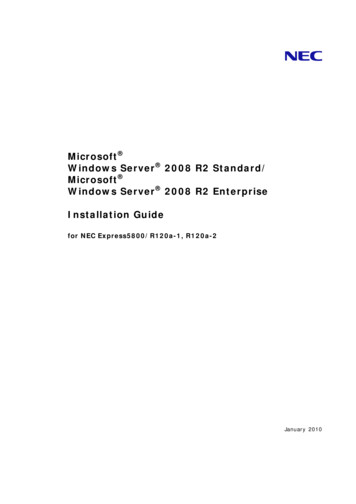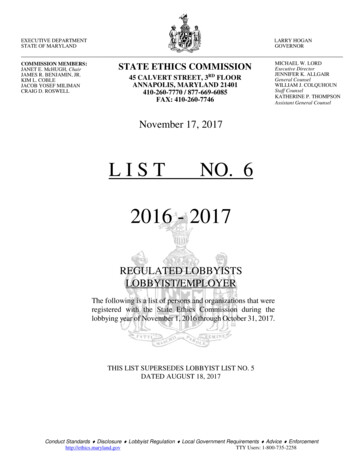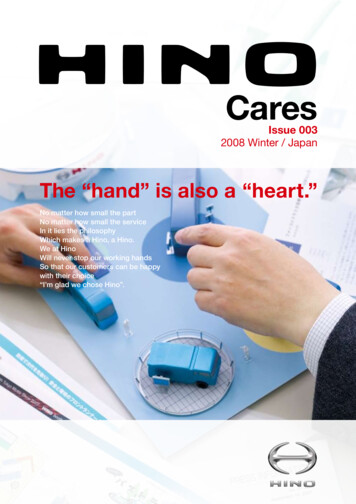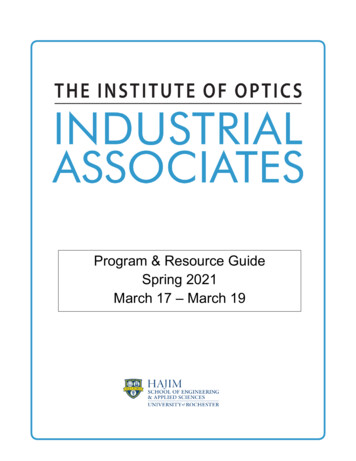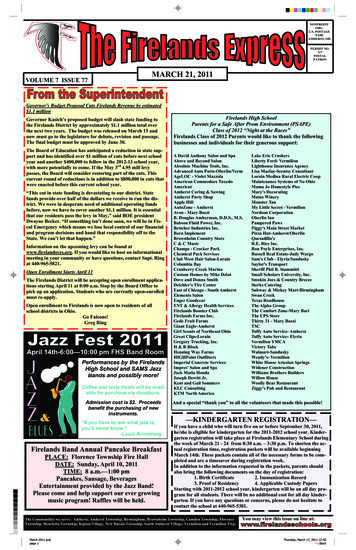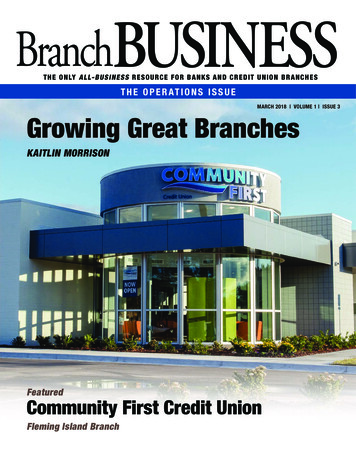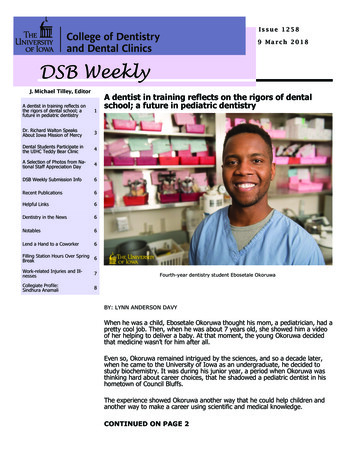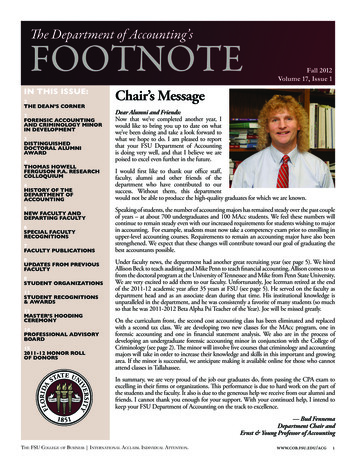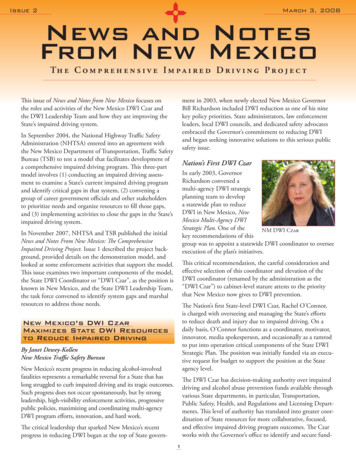
Transcription
Issue 2March 3, 2008News and NotesFrom New MexicoTh e C o m p r e h e n s i v e I m p a i r e d D r i v i n g P r o j e c tThis issue of News and Notes from New Mexico focuses onthe roles and activities of the New Mexico DWI Czar andthe DWI Leadership Team and how they are improving theState’s impaired driving system.ment in 2003, when newly elected New Mexico GovernorBill Richardson included DWI reduction as one of his ninekey policy priorities. State administrators, law enforcementleaders, local DWI councils, and dedicated safety advocatesembraced the Governor’s commitment to reducing DWIand began seeking innovative solutions to this serious publicsafety issue.In September 2004, the National Highway Traffic SafetyAdministration (NHTSA) entered into an agreement withthe New Mexico Department of Transportation, Traffic SafetyBureau (TSB) to test a model that facilitates development ofa comprehensive impaired driving program. This three-partmodel involves (1) conducting an impaired driving assessment to examine a State’s current impaired driving programand identify critical gaps in that system, (2) convening agroup of career government officials and other stakeholdersto prioritize needs and organize resources to fill those gaps,and (3) implementing activities to close the gaps in the State’simpaired driving system.Nation’s First DWI CzarIn early 2003, GovernorRichardson convened amulti-agency DWI strategicplanning team to developa statewide plan to reduceDWI in New Mexico, NewMexico Multi-Agency DWIStrategic Plan. One of theNM DWI Czarkey recommendations of thisgroup was to appoint a statewide DWI coordinator to overseeexecution of the plan’s initiatives.In November 2007, NHTSA and TSB published the initialNews and Notes From New Mexico: The ComprehensiveImpaired Driving Project. Issue 1 described the project background, provided details on the demonstration model, andlooked at some enforcement activities that support the model.This issue examines two important components of the model,the State DWI Coordinator or “DWI Czar”, as the position isknown in New Mexico, and the State DWI Leadership Team,the task force convened to identify system gaps and marshalresources to address those needs.This critical recommendation, the careful consideration andeffective selection of this coordinator and elevation of theDWI coordinator (renamed by the administration as the“DWI Czar”) to cabinet-level stature attests to the prioritythat New Mexico now gives to DWI prevention.The Nation’s first State-level DWI Czar, Rachel O’Connor,is charged with overseeing and managing the State’s effortsto reduce death and injury due to impaired driving. On adaily basis, O’Connor functions as a coordinator, motivator,innovator, media spokesperson, and occasionally as a ramrodto put into operation critical components of the State DWIStrategic Plan. The position was initially funded via an executive request for budget to support the position at the Stateagency level.New Mexico’s DWI CzarMaximizes State DWI Resourcesto Reduce Impaired DrivingBy Janet Dewey-KollenNew Mexico Traffic Safety BureauNew Mexico’s recent progress in reducing alcohol-involvedfatalities represents a remarkable reversal for a State that haslong struggled to curb impaired driving and its tragic outcomes.Such progress does not occur spontaneously, but by strongleadership, high-visibility enforcement activities, progressivepublic policies, maximizing and coordinating multi-agencyDWI program efforts, innovation, and hard work.The DWI Czar has decision-making authority over impaireddriving and alcohol abuse prevention funds available throughvarious State departments, in particular, Transportation,Public Safety, Health, and Regulations and Licensing Departments. This level of authority has translated into greater coordination of State resources for more collaborative, focused,and effective impaired driving program outcomes. The Czarworks with the Governor’s office to identify and secure fund-The critical leadership that sparked New Mexico’s recentprogress in reducing DWI began at the top of State govern
ing for critical programs through State budgets, via Federalgrants, or through inclusion in the annual Governor’s budgetand public policy package.Public Policy ChangesTough and innovative public policy changes are some of thepositive outcomes in New Mexico facilitated by coordinatedDWI efforts. At the urging of the DWI Czar and backed by acoordinated network of advocacy and public safety supporters, the New Mexico Legislature enacted several importantand innovative statutes, which have stimulated much of theprogress to date. These statutes include creating an alcoholignition interlock license provision, mandating alcohol ignition interlocks for all DWI-convicted offenders (includingfirst offenders), and mandating treatment for second andsubsequent DWI offenders.Another groundbreaking public policy initiative is the development and aggressive enforcement of a tough new liquorlicense rule that allows only three violations within 12 monthsfor sales to intoxicated persons and sales to minors. In 2005,the Governor’s Office convened a task force to study andmake recommendations for penalties regarding violations ofthe State’s Liquor Control Act. Based on those recommendations, in 2006, the State passed the “Three Strikes” regulations that mandate the revocation of a liquor license for thoseestablishments that chronically serve minors or intoxicatedpeople. O’Connor worked collaboratively with both the Alcohol and Gaming Division of the New Mexico Regulation andLicensing Department and the Special Investigations Divisionof the Department of Public Safety to enforce these new rules.Currently, revocation proceedings are pending against at leastsix liquor licensees and more revocation announcements areexpected in 2008.At the Czar’s request, the Legislature also provided fundingfor innovative new programs, including an interlock compliance unit at the Motor Vehicle Division (MVD), funds fora Mobile Strike Unit to conduct enforcement activities andcompliance checks at bars and restaurants, funds for a Drunkbusters #DWI Hotline, and money to include ProtectingYou, Protecting Me, MADD’s (Mothers Against Drunk Driving) early education DWI prevention curriculum in schoolsaround the State. Funds were also used to support additionalMVD hearing officers and to provide other State resources.Innovative ProgrammingThe following programs and initiatives represent the rangeand innovation of New Mexico’s impaired driving effortscoordinated by its DWI Czar:O’Connor works with a variety of public agencies including the State Departments of Transportation, Regulationand Licensing, Public Safety and Health to initiate statewideDWI efforts. The State’s Traffic Safety Bureau (TSB) Director, Michael Sandoval, whose agency is housed within theNew Mexico Department of Transportation, works closelywith the DWI Czar to fund impaired driving enforcementefforts. The TSB provides county-level Operation DWIfunding for coordinated checkpoint and saturation patrolcampaigns, and for enhanced enforcement using full-timeDWI officers as part of a six-county innovative impaireddriving demonstration project.Supporting increased enforcement efforts including astatewide Superblitz program and funds for full-timelaw enforcement for counties where DWI is deadliest inNew Mexico;Developing and implementing an intensive multimediaeffort designed to reach specific ethnic and demographicgroups; and funding outreach coordinators in highincidence counties;Developing and securing funding for a statewide hotlineso citizens can report impaired driving and working withcell phone providers to have the number preprogrammedinto cell phones;The TSB also supports a massive statewide public awarenesscampaign as well as non-traditional public awareness strategies in the six counties with the most severe DWI problem.Creating a State-Tribal DWI Task Force to developplans for reducing alcohol-related traffic fatalities ontribal lands;An unusual collaborative project initiated under the DWICzar’s leadership seeks to reduce DWI recidivism among firstoffense DWI offenders. The pilot project funded by the TSBand administered by the Albuquerque Metropolitan Court,the largest court system in the State, offers early interventionand additional probation services (including mandatory ignition interlock use) to first-time offenders whose screeningresults indicate a high risk for re-offending.Hiring a Tribal DWI Coordinator and developingone of the Nation’s first Tribal DWI television publicservice announcement;Working cooperatively with tribes to initiate crosscommissioning and data sharing agreements on DWI; and
Initiating a judicial summit to research and addressissues related to the adjudication of DWI cases resultingin additional funding for judgeships across the Stateand providing funds to MADD for a court monitoringproject in high-incidence counties.Team provides a forum for vital interaction by career representatives of State agencies and non-governmental groups. Since2004, group members have met monthly to make decisionson DWI priorities and programs, work to solve ongoing challenges, initiate innovative programs, and evaluate progress.New Mexico’s premise that significant DWI reduction canbest be achieved through a multi-agency, systems approachheaded by a DWI coordinator with broad jurisdiction andresponsibility appears to have merit. Perhaps more State-level“super-coordinators” who can and will force priorities, holdstakeholders accountable, and make tough decisions regardingDWI programming is an innovation that should be considered for the next frontier of DWI prevention.Another critical factor in the State’s progress is collaborationamong law enforcement leaders; New Mexico Traffic SafetyBureau Director Michael Sandoval; and other New Mexicogovernment department, agency, bureau, and division-levelleaders. The cooperation among these officials, and theirleadership within their own organizations, has transformedDWI prevention work in the State from an individualagency responsibility to a true statewide commitment andteamwork approach.DWI Leadership Team in NewMexico Stimulates Innovation,Collaboration, and ProgressStrategic Planning ProcessWhile many States have used statewide DWI strategic plans,this approach has been especially important to New Mexico’srejuvenated and successful anti-DWI efforts over the past fiveyears. New Mexico developed a far-reaching, multi-agencyplan and followed up by executing the majority of the plan’sobjectives as well as implementing complementary initiatives.Upon taking office in 2003, Governor Richardson chargedthree Cabinet Secretaries from the Departments of Health,Public Safety, and Corrections to develop a statewide DWIstrategic plan based on a multi-agency, systems approach.Approximately 70 stakeholders representing public andprivate organizations contributed to the planning sessions.Leadership Team/NetworkingBy Janet Dewey-KollenNew Mexico Traffic Safety BureauFrom 2003-2006, at a time when the national DWI problem remained essentially level, New Mexico experienced a15‑percent decrease in alcohol-involved fatalities. Withoutdoubt, intense and high-visibility enforcement, strong mediamessaging, innovative programs, and critical public policychanges drove this progress, but how were these effortsconceived, coordinated, and implemented? Public and privatesafety stakeholders agree that leadership from several distinctsectors made this progress possible.First, Governor Bill Richardson has made reducing DWI inNew Mexico one of nine policy priorities for his administration. The Governor demonstrates his ongoing commitmentto reducing impaired driving through his program, fiscal,and legislative agendas; his presence at DWI events includingsobriety checkpoints and other venues; and by initiating publicpolicy and budget efforts to support anti-DWI measures.Participants included representatives from the State Departments of Corrections; Health; Finance and Administration;Public Safety; Regulation and Licensing; Children, Youth andFamilies; Motor Vehicles Division; New Mexico Administrative Offices of the Courts and of the District Attorney; theAttorney General’s and Public Defender’s Offices; and theUniversity of New Mexico’s Public Law Institute and Divisionof Governmental Research. Representatives from county-levelgovernment, Native American tribes, and anti-DWI advocacy groups actively participated in the nine-month planningprocess as well.Completed in December 2003, the New Mexico Multi-AgencyDWI Strategic Plan identified 23 initiatives divided amongcore strategic areas: Prevention, Law Enforcement, Adjudication, Treatment and Rehabilitation, and an overall categorythat would strengthen all core areas.Key strategic priorities of New Mexico’s plan are:Develop a comprehensive DWI data system;Create the position of a statewide DWI Czar;The New Mexico DWI Leadership Team is a key factor in theState’s progress in reducing impaired-driving. The LeadershipBalance funding for all State agencies in DWI process;
Fund the cost of mandatory sentencing to the criminaljustice system;members up-to-date on schedules for important hearings,relevant court findings, earned media opportunities, etc.Develop a statewide vehicle forfeiture initiative;Currently, the DWI Leadership Team is conducting an extensive review of the status of the original 23 recommendationsfrom the 2003 New Mexico Multi-Agency DWI Strategic Plan.A subcommittee will then analyze this review and bring backto the team new recommendations for ongoing efforts.Increase funding for law enforcement equipment andpersonnel;Increase DWI checkpoint operations;Establish performance criteria for treatment and otherDWI interventions;DWI Leadership Team in ActionDevelop an electronic scheduling process to streamlineDWI adjudication;A decision in 2007 about how to divide unallocated StateDWI resources totaling 600,000 reflects the LeadershipTeam’s ability to collectively make decisions on priorities.When challenged to decide what needs should be addressedwith these funds, the team divided the money among threeinitiatives – additional equipment for DWI enforcement,overtime funds for officers working with the newly formedSpecial Investigations Division of the New Mexico Department of Public Safety (who investigate liquor licenseessuspected of serving intoxicated or underage patrons), andan evaluation of best practices and cost effectiveness of DWI/Drug Courts.Create a statewide DWI prevention media campaign; andExpand DWI/Drug Courts.New Mexico’s DWI Leadership TeamThe New Mexico DWI Leadership Team has proven to be anessential resource in the State’s DWI reduction efforts. TheLeadership Team works to coordinate programs within variousState agencies to maximize enforcement, adjudication, treatment, public awareness, and other DWI prevention effortsstatewide. Special emphasis is placed in the six New Mexicocounties with the highest number of alcohol-involved fatalities.One particularly beneficial activity at the beginning of eachmeeting is the Agency Update when attendees report activitiesby their respective agencies and organizations. This dialoguenot only serves to inform members, but also provides anopportunity for all State agencies to bring impaired-drivingrelated issues to an Executive Level, and for participants togive input to the Governor’s Legislative package from bothpolicy and budget perspectives.Led by DWI Czar Rachel O’Connor and Traffic SafetyBureau Director Michael Sandoval, the Leadership Teammeets monthly and attendance is consistently high (morethan 40 attendees). Rather than seeking the formality of anexecutive order to establish the Leadership Team, O’Connorand Sandoval believe that the informal and flexible nature ofthe group provides for stability and sustainability, and allowsthe team to function on a collaborative basis. Further, since amajority of current Leadership Team members served on the2003 Multi-Agency DWI Strategic Planning Team, the groupfunctions with an impressive level of institutional memoryand continuity.Sharing information on individual agency programs andplans often stimulates direct and sidebar discussions leading to even more collaborative outcomes. Examples of jointefforts include:During a review of progress on law enforcement tasks inthe strategic plan, the team discussed new ways to assistenforcement agencies in rounding up DWI offenderswith outstanding bench warrants. A representative of theState’s county-level impaired driving programs suggestedthat county programs could help by conducting localwarrant roundups. A subsequent e-mail sent by the team’sDivision of Finance and Administration representativeto county impaired driving program administratorsauthorizing this activity and requesting a quick responseresulted in numerous local warrant roundups.Members tend to be from the career, operational level of Stateagencies and local government. Participation by bureau chiefsand division directors instead of cabinet-level or politicalappointees assures that management from various State agencies are involved in critical discussions and are empowered totake specific ideas and issues back to their agencies for action.In addition, representatives from non-governmental andadvocacy organizations provide valuable perspective.Meetings typically include special presentations on bestpractice or innovative enforcement, health, treatment, screening, or other program areas by local, national, or even international experts. Monthly reports on current projects andupcoming media activities close out every meeting. Communication among DWI Leadership Team members occursoutside of meetings as well as through frequent blast e-mailssent by the DWI Czar’s office. These messages help keepThe Leadership Team recently sponsored a LawEnforcement Leaders Summit in an effort to betterunderstand the challenges agencies and officers facerelative to impaired driving enforcement, and todetermine what additional State resources might assistagencies in mitigating these challenges.
Need Additional Information?A subcommittee is meeting to review and updateprocedures and guidelines for county-level impaired drivingprograms (funded through alcohol taxes and offender fees).Objectives of this review are to standardize and maximizeefficiency of local initiatives and to coordinate local effortswith overall State goals and priorities.If you need additional information regarding the NewMexico impaired driving demonstration project, contactone of the following:Joey SynerNHTSA, NTI-1111200 New Jersey Avenue SE.Washington, DC 20590202-366-1770joey.syner@dot.govVarious Leadership Team discussions pointed out a needto “clean up” several provisions in the State’s impaireddriving statute, an objective current being addressedthrough a team subcommittee.After a presentation on Tru Touch Technology’s newtransdermal alcohol testing units, the team agreed to pilottest the technology, and decided to include a court-based,enhanced supervision program for DWI first offendersand a county-based treatment program as initial test sites.Pat TuckerNHTSA Region 6819 Taylor Street, Room 8A38Fort Worth, TX 76102-6177817-978-0180pat.tucker@dot.govIn an attempt to diversify and expand New Mexico’scurrent DWI strategic portfolio in ways that all keypartners endorse and support, a subcommittee compiledan extensive summary of existing DWI treatment andprevention activities in the State. The New Mexico DWIepidemiologist (who sits on the Leadership Team) thencompared this inventory against a matrix of accepted,evidence-based impaired driving prevention strategiesand developed recommendations for future critical andcutting edge initiatives.Maria MartinezNM Traffic Safety Bureau604 West San Mateo RoadSanta Fe, NM 87505505-827-1581mariae.martinez@state.nm.usThese folks would also like to know if you f
and administered by the Albuquerque Metropolitan Court, the largest court system in the State, offers early intervention and additional probation services (including mandatory igni-tion interlock use) to first-time offenders whose screening results indicate a high risk for re-offending. Anot

